Factors Affecting Private Housing Prices in the UK
VerifiedAdded on 2023/01/19
|17
|4228
|78
AI Summary
This report analyzes the factors influencing the price of private housing in the UK, including supply and demand dynamics. It also discusses government policies to stimulate housing demand.
Contribute Materials
Your contribution can guide someone’s learning journey. Share your
documents today.
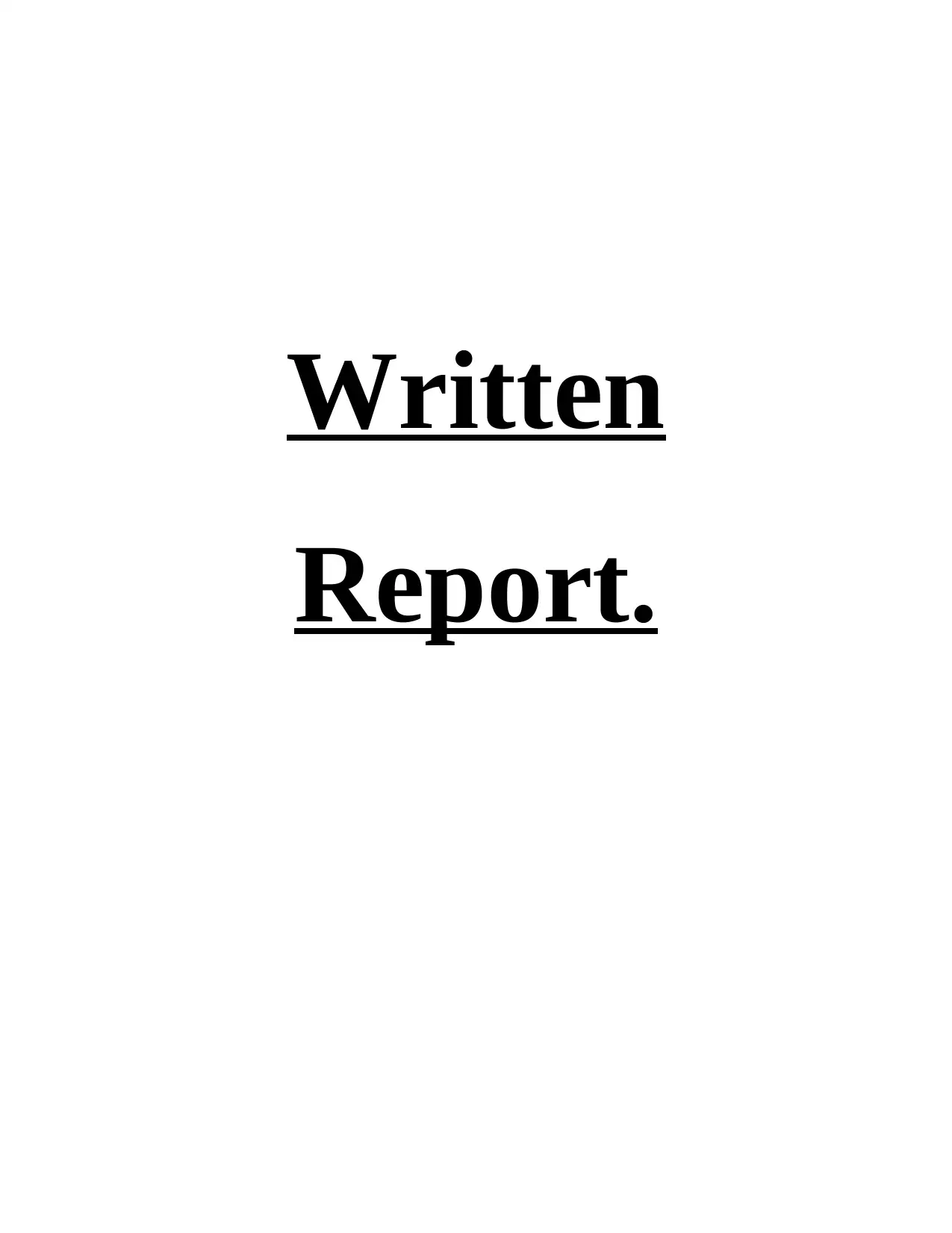
Written
Report.
Report.
Secure Best Marks with AI Grader
Need help grading? Try our AI Grader for instant feedback on your assignments.
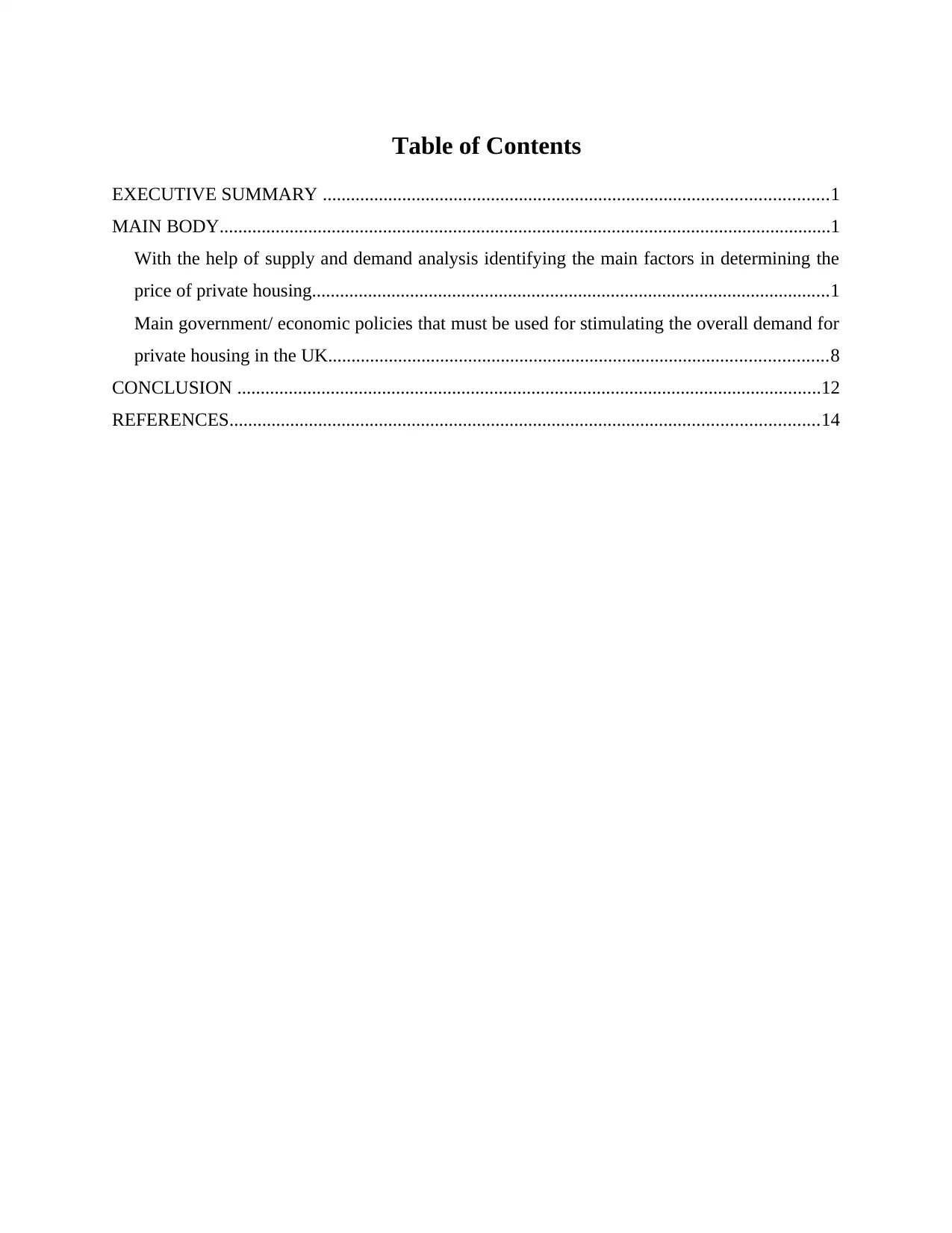
Table of Contents
EXECUTIVE SUMMARY ............................................................................................................1
MAIN BODY...................................................................................................................................1
With the help of supply and demand analysis identifying the main factors in determining the
price of private housing...............................................................................................................1
Main government/ economic policies that must be used for stimulating the overall demand for
private housing in the UK...........................................................................................................8
CONCLUSION .............................................................................................................................12
REFERENCES..............................................................................................................................14
EXECUTIVE SUMMARY ............................................................................................................1
MAIN BODY...................................................................................................................................1
With the help of supply and demand analysis identifying the main factors in determining the
price of private housing...............................................................................................................1
Main government/ economic policies that must be used for stimulating the overall demand for
private housing in the UK...........................................................................................................8
CONCLUSION .............................................................................................................................12
REFERENCES..............................................................................................................................14
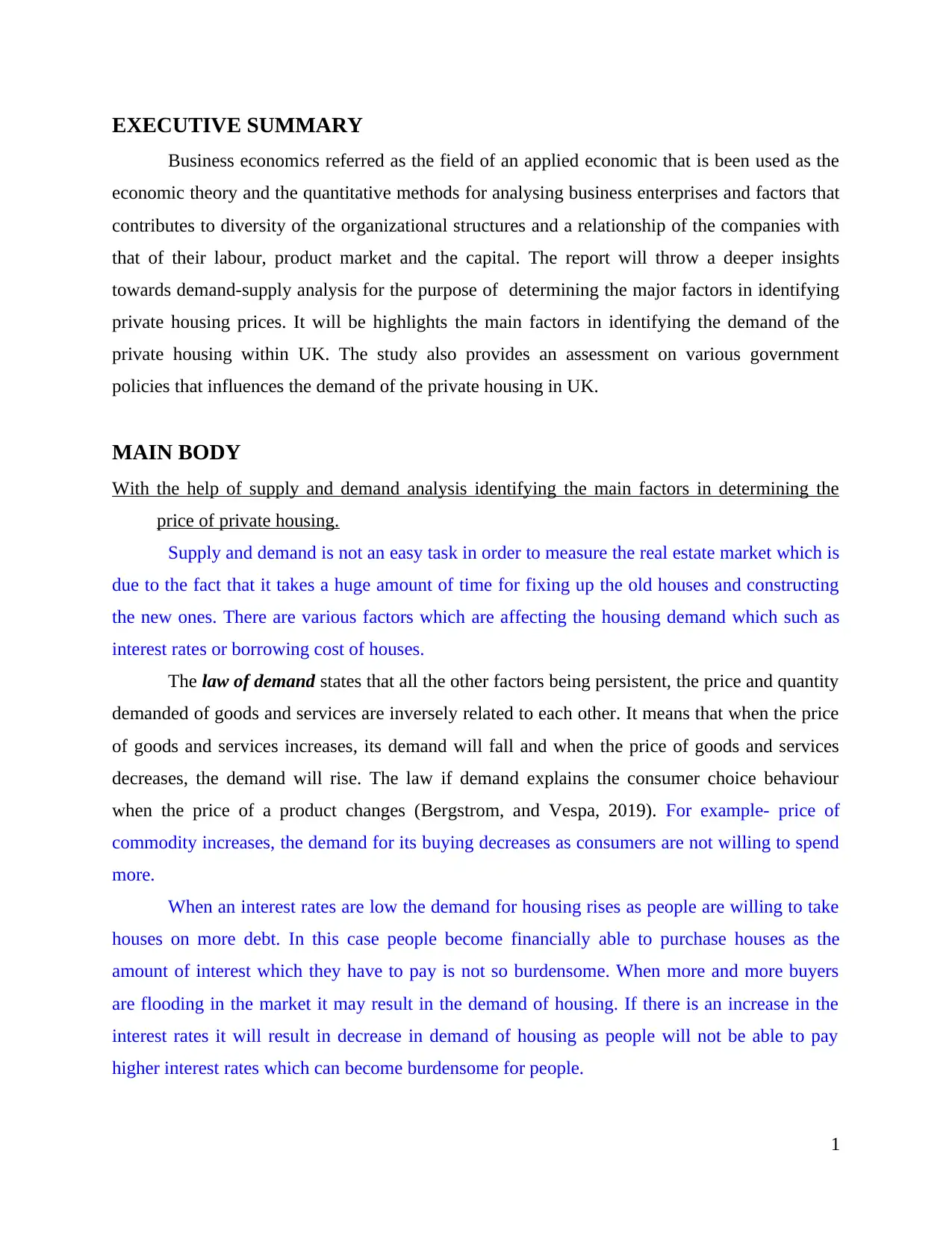
EXECUTIVE SUMMARY
Business economics referred as the field of an applied economic that is been used as the
economic theory and the quantitative methods for analysing business enterprises and factors that
contributes to diversity of the organizational structures and a relationship of the companies with
that of their labour, product market and the capital. The report will throw a deeper insights
towards demand-supply analysis for the purpose of determining the major factors in identifying
private housing prices. It will be highlights the main factors in identifying the demand of the
private housing within UK. The study also provides an assessment on various government
policies that influences the demand of the private housing in UK.
MAIN BODY
With the help of supply and demand analysis identifying the main factors in determining the
price of private housing.
Supply and demand is not an easy task in order to measure the real estate market which is
due to the fact that it takes a huge amount of time for fixing up the old houses and constructing
the new ones. There are various factors which are affecting the housing demand which such as
interest rates or borrowing cost of houses.
The law of demand states that all the other factors being persistent, the price and quantity
demanded of goods and services are inversely related to each other. It means that when the price
of goods and services increases, its demand will fall and when the price of goods and services
decreases, the demand will rise. The law if demand explains the consumer choice behaviour
when the price of a product changes (Bergstrom, and Vespa, 2019). For example- price of
commodity increases, the demand for its buying decreases as consumers are not willing to spend
more.
When an interest rates are low the demand for housing rises as people are willing to take
houses on more debt. In this case people become financially able to purchase houses as the
amount of interest which they have to pay is not so burdensome. When more and more buyers
are flooding in the market it may result in the demand of housing. If there is an increase in the
interest rates it will result in decrease in demand of housing as people will not be able to pay
higher interest rates which can become burdensome for people.
1
Business economics referred as the field of an applied economic that is been used as the
economic theory and the quantitative methods for analysing business enterprises and factors that
contributes to diversity of the organizational structures and a relationship of the companies with
that of their labour, product market and the capital. The report will throw a deeper insights
towards demand-supply analysis for the purpose of determining the major factors in identifying
private housing prices. It will be highlights the main factors in identifying the demand of the
private housing within UK. The study also provides an assessment on various government
policies that influences the demand of the private housing in UK.
MAIN BODY
With the help of supply and demand analysis identifying the main factors in determining the
price of private housing.
Supply and demand is not an easy task in order to measure the real estate market which is
due to the fact that it takes a huge amount of time for fixing up the old houses and constructing
the new ones. There are various factors which are affecting the housing demand which such as
interest rates or borrowing cost of houses.
The law of demand states that all the other factors being persistent, the price and quantity
demanded of goods and services are inversely related to each other. It means that when the price
of goods and services increases, its demand will fall and when the price of goods and services
decreases, the demand will rise. The law if demand explains the consumer choice behaviour
when the price of a product changes (Bergstrom, and Vespa, 2019). For example- price of
commodity increases, the demand for its buying decreases as consumers are not willing to spend
more.
When an interest rates are low the demand for housing rises as people are willing to take
houses on more debt. In this case people become financially able to purchase houses as the
amount of interest which they have to pay is not so burdensome. When more and more buyers
are flooding in the market it may result in the demand of housing. If there is an increase in the
interest rates it will result in decrease in demand of housing as people will not be able to pay
higher interest rates which can become burdensome for people.
1
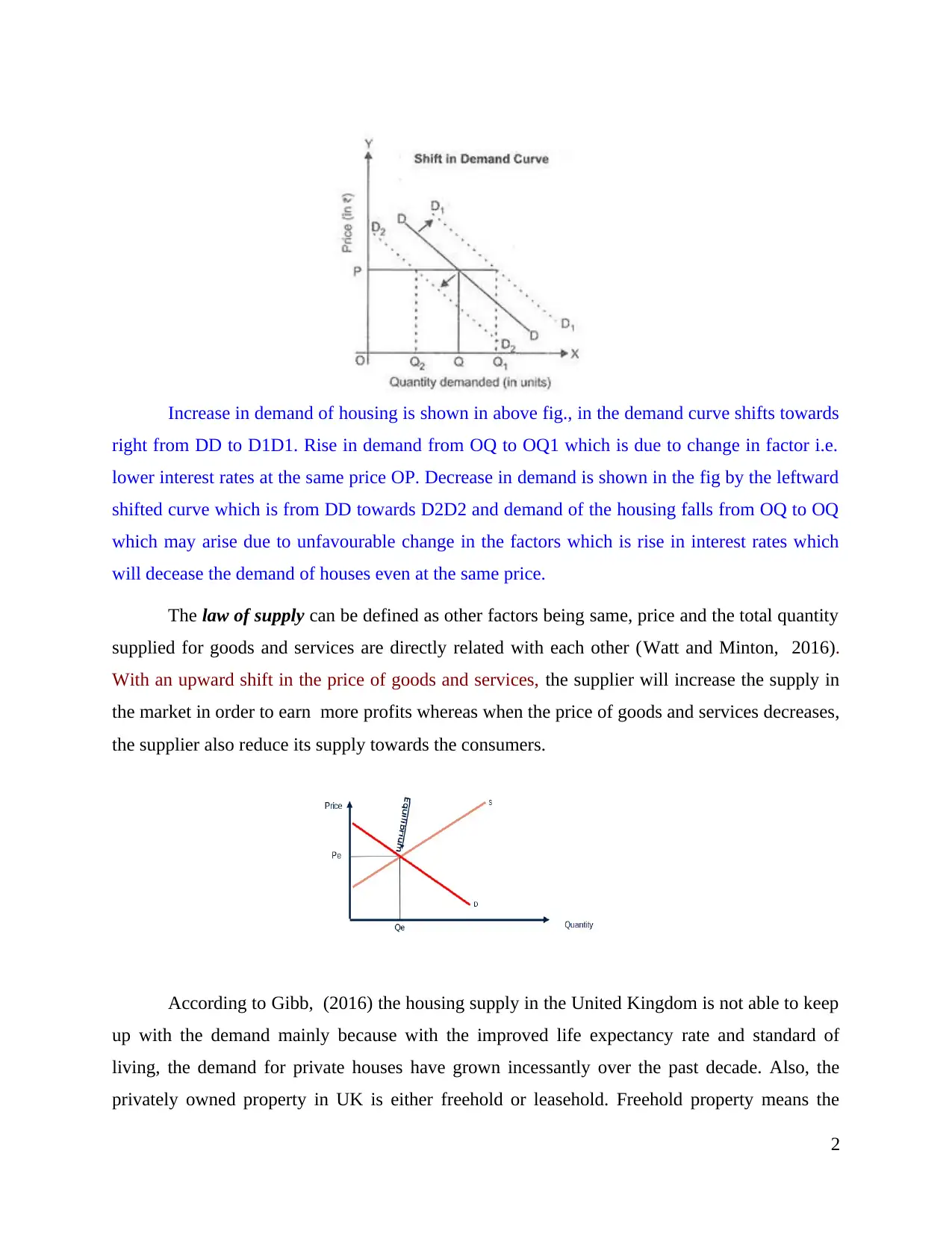
Increase in demand of housing is shown in above fig., in the demand curve shifts towards
right from DD to D1D1. Rise in demand from OQ to OQ1 which is due to change in factor i.e.
lower interest rates at the same price OP. Decrease in demand is shown in the fig by the leftward
shifted curve which is from DD towards D2D2 and demand of the housing falls from OQ to OQ
which may arise due to unfavourable change in the factors which is rise in interest rates which
will decease the demand of houses even at the same price.
The law of supply can be defined as other factors being same, price and the total quantity
supplied for goods and services are directly related with each other (Watt and Minton, 2016).
With an upward shift in the price of goods and services, the supplier will increase the supply in
the market in order to earn more profits whereas when the price of goods and services decreases,
the supplier also reduce its supply towards the consumers.
According to Gibb, (2016) the housing supply in the United Kingdom is not able to keep
up with the demand mainly because with the improved life expectancy rate and standard of
living, the demand for private houses have grown incessantly over the past decade. Also, the
privately owned property in UK is either freehold or leasehold. Freehold property means the
2
right from DD to D1D1. Rise in demand from OQ to OQ1 which is due to change in factor i.e.
lower interest rates at the same price OP. Decrease in demand is shown in the fig by the leftward
shifted curve which is from DD towards D2D2 and demand of the housing falls from OQ to OQ
which may arise due to unfavourable change in the factors which is rise in interest rates which
will decease the demand of houses even at the same price.
The law of supply can be defined as other factors being same, price and the total quantity
supplied for goods and services are directly related with each other (Watt and Minton, 2016).
With an upward shift in the price of goods and services, the supplier will increase the supply in
the market in order to earn more profits whereas when the price of goods and services decreases,
the supplier also reduce its supply towards the consumers.
According to Gibb, (2016) the housing supply in the United Kingdom is not able to keep
up with the demand mainly because with the improved life expectancy rate and standard of
living, the demand for private houses have grown incessantly over the past decade. Also, the
privately owned property in UK is either freehold or leasehold. Freehold property means the
2
Secure Best Marks with AI Grader
Need help grading? Try our AI Grader for instant feedback on your assignments.
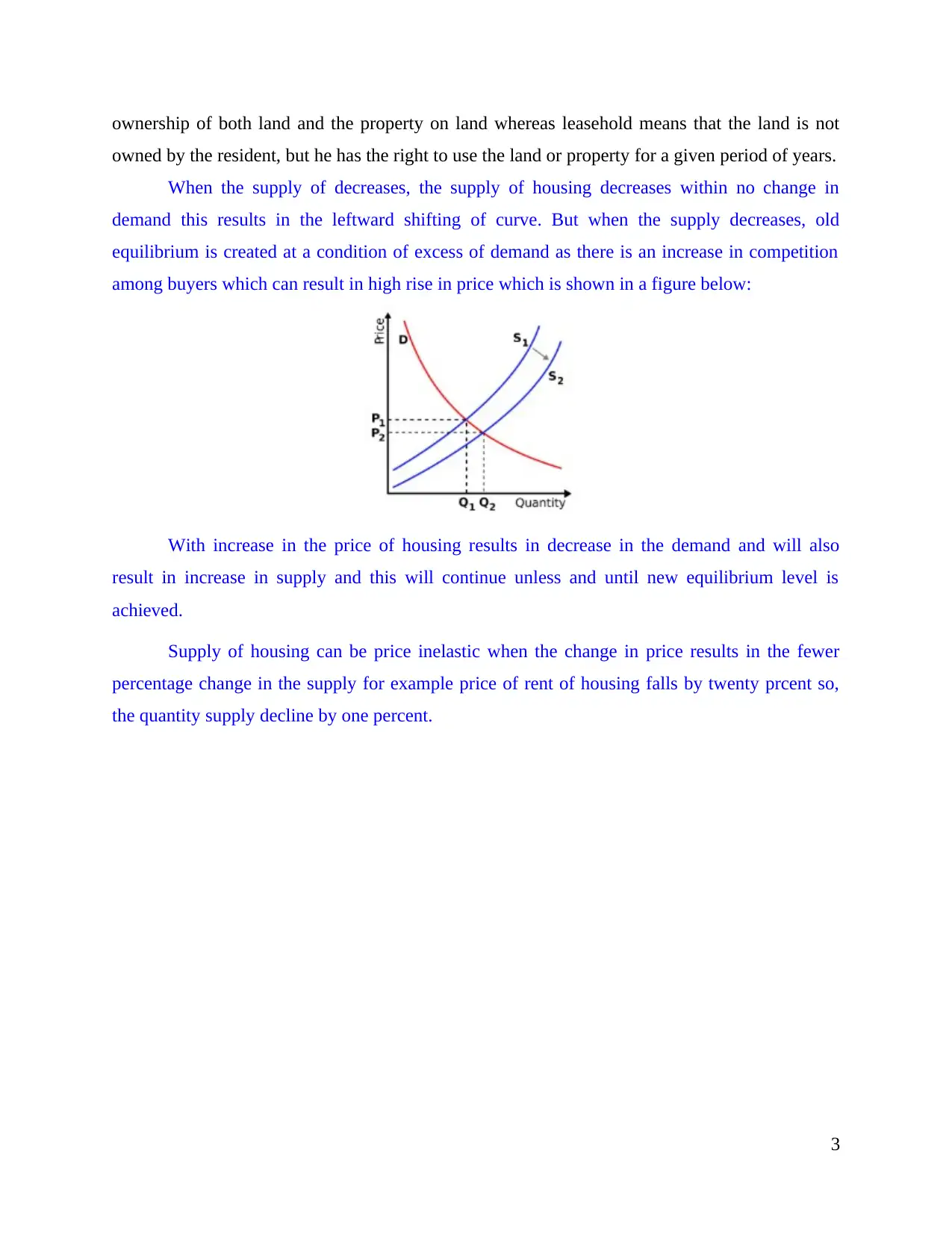
ownership of both land and the property on land whereas leasehold means that the land is not
owned by the resident, but he has the right to use the land or property for a given period of years.
When the supply of decreases, the supply of housing decreases within no change in
demand this results in the leftward shifting of curve. But when the supply decreases, old
equilibrium is created at a condition of excess of demand as there is an increase in competition
among buyers which can result in high rise in price which is shown in a figure below:
With increase in the price of housing results in decrease in the demand and will also
result in increase in supply and this will continue unless and until new equilibrium level is
achieved.
Supply of housing can be price inelastic when the change in price results in the fewer
percentage change in the supply for example price of rent of housing falls by twenty prcent so,
the quantity supply decline by one percent.
3
owned by the resident, but he has the right to use the land or property for a given period of years.
When the supply of decreases, the supply of housing decreases within no change in
demand this results in the leftward shifting of curve. But when the supply decreases, old
equilibrium is created at a condition of excess of demand as there is an increase in competition
among buyers which can result in high rise in price which is shown in a figure below:
With increase in the price of housing results in decrease in the demand and will also
result in increase in supply and this will continue unless and until new equilibrium level is
achieved.
Supply of housing can be price inelastic when the change in price results in the fewer
percentage change in the supply for example price of rent of housing falls by twenty prcent so,
the quantity supply decline by one percent.
3
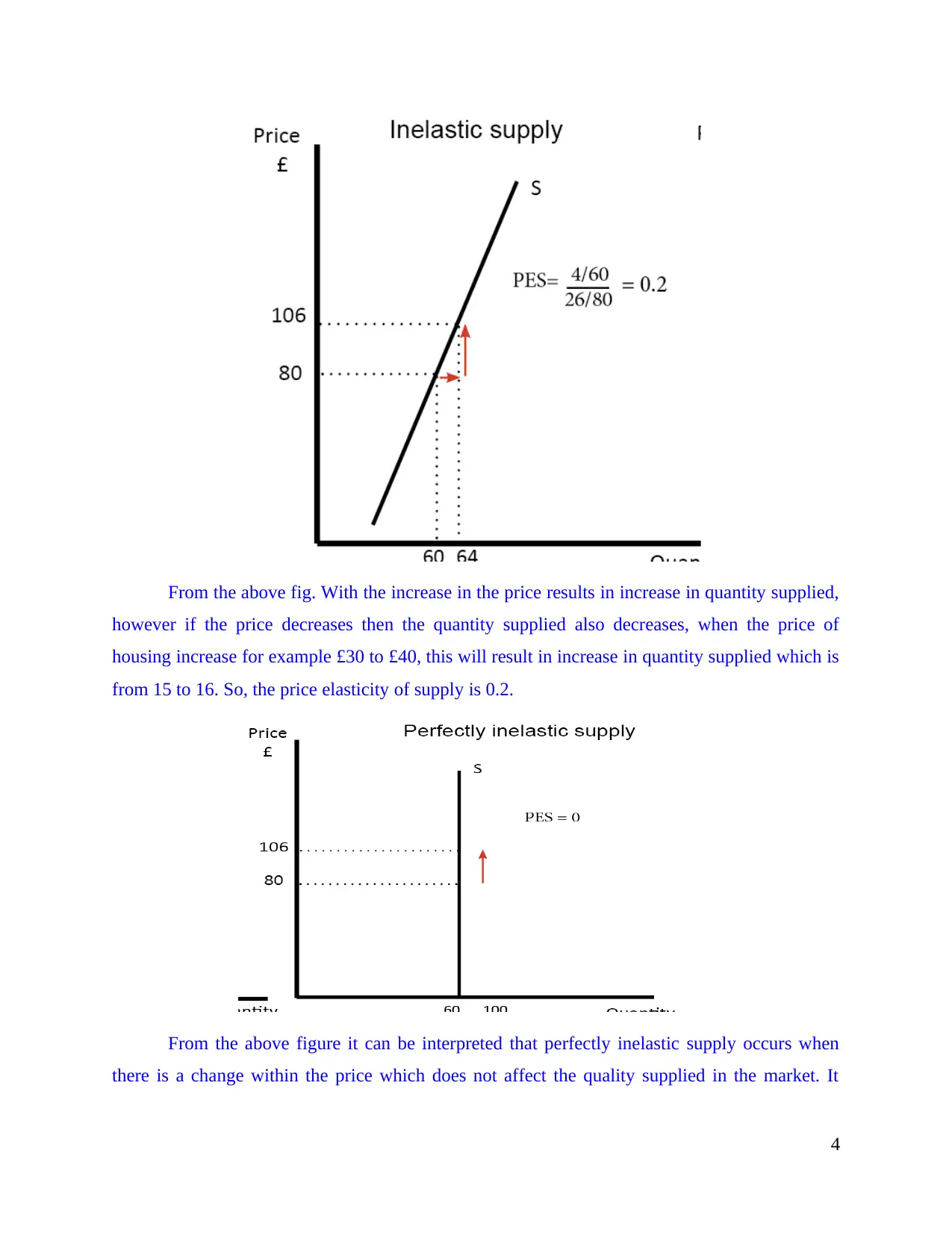
From the above fig. With the increase in the price results in increase in quantity supplied,
however if the price decreases then the quantity supplied also decreases, when the price of
housing increase for example £30 to £40, this will result in increase in quantity supplied which is
from 15 to 16. So, the price elasticity of supply is 0.2.
From the above figure it can be interpreted that perfectly inelastic supply occurs when
there is a change within the price which does not affect the quality supplied in the market. It
4
however if the price decreases then the quantity supplied also decreases, when the price of
housing increase for example £30 to £40, this will result in increase in quantity supplied which is
from 15 to 16. So, the price elasticity of supply is 0.2.
From the above figure it can be interpreted that perfectly inelastic supply occurs when
there is a change within the price which does not affect the quality supplied in the market. It
4
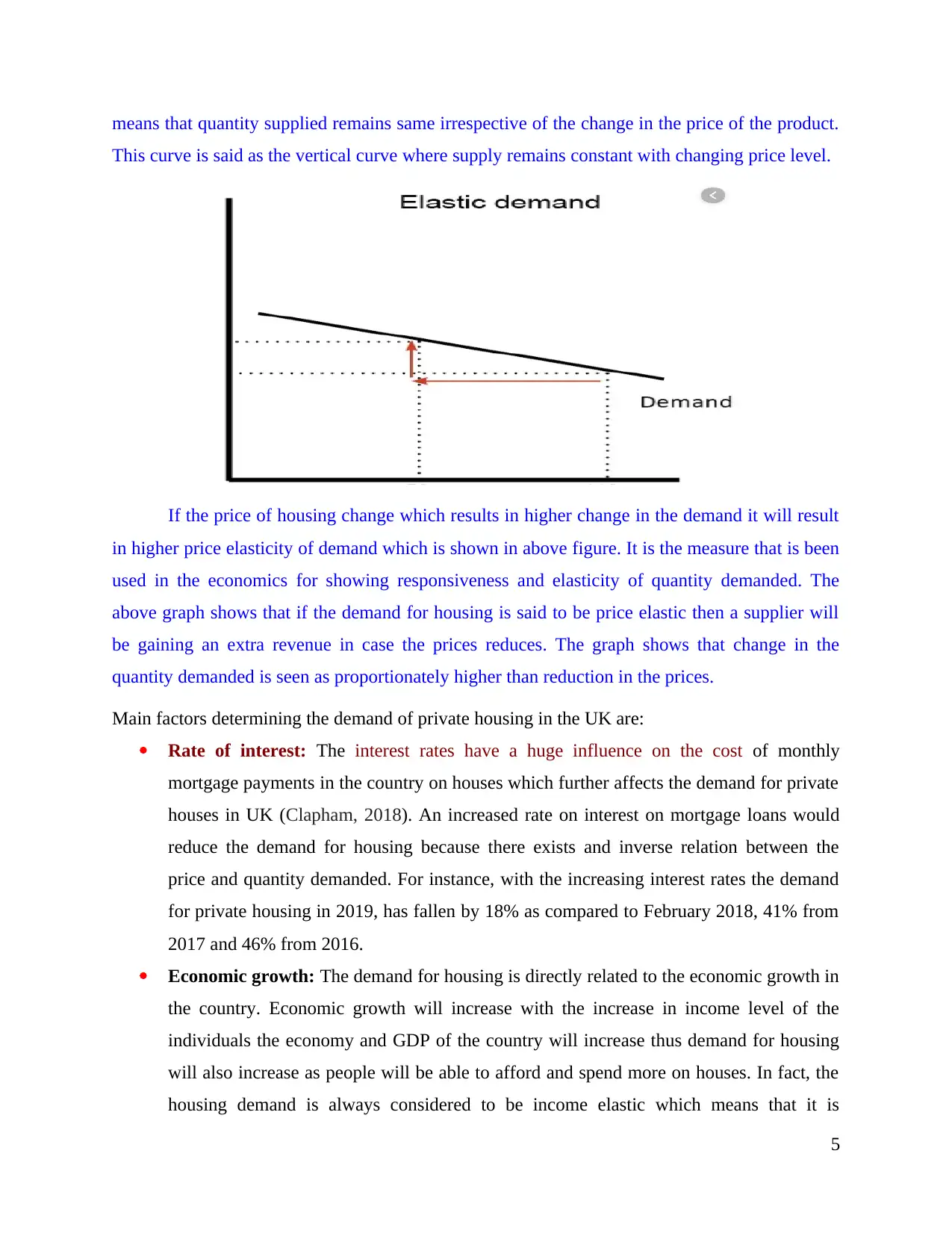
means that quantity supplied remains same irrespective of the change in the price of the product.
This curve is said as the vertical curve where supply remains constant with changing price level.
If the price of housing change which results in higher change in the demand it will result
in higher price elasticity of demand which is shown in above figure. It is the measure that is been
used in the economics for showing responsiveness and elasticity of quantity demanded. The
above graph shows that if the demand for housing is said to be price elastic then a supplier will
be gaining an extra revenue in case the prices reduces. The graph shows that change in the
quantity demanded is seen as proportionately higher than reduction in the prices.
Main factors determining the demand of private housing in the UK are:
Rate of interest: The interest rates have a huge influence on the cost of monthly
mortgage payments in the country on houses which further affects the demand for private
houses in UK (Clapham, 2018). An increased rate on interest on mortgage loans would
reduce the demand for housing because there exists and inverse relation between the
price and quantity demanded. For instance, with the increasing interest rates the demand
for private housing in 2019, has fallen by 18% as compared to February 2018, 41% from
2017 and 46% from 2016.
Economic growth: The demand for housing is directly related to the economic growth in
the country. Economic growth will increase with the increase in income level of the
individuals the economy and GDP of the country will increase thus demand for housing
will also increase as people will be able to afford and spend more on houses. In fact, the
housing demand is always considered to be income elastic which means that it is
5
This curve is said as the vertical curve where supply remains constant with changing price level.
If the price of housing change which results in higher change in the demand it will result
in higher price elasticity of demand which is shown in above figure. It is the measure that is been
used in the economics for showing responsiveness and elasticity of quantity demanded. The
above graph shows that if the demand for housing is said to be price elastic then a supplier will
be gaining an extra revenue in case the prices reduces. The graph shows that change in the
quantity demanded is seen as proportionately higher than reduction in the prices.
Main factors determining the demand of private housing in the UK are:
Rate of interest: The interest rates have a huge influence on the cost of monthly
mortgage payments in the country on houses which further affects the demand for private
houses in UK (Clapham, 2018). An increased rate on interest on mortgage loans would
reduce the demand for housing because there exists and inverse relation between the
price and quantity demanded. For instance, with the increasing interest rates the demand
for private housing in 2019, has fallen by 18% as compared to February 2018, 41% from
2017 and 46% from 2016.
Economic growth: The demand for housing is directly related to the economic growth in
the country. Economic growth will increase with the increase in income level of the
individuals the economy and GDP of the country will increase thus demand for housing
will also increase as people will be able to afford and spend more on houses. In fact, the
housing demand is always considered to be income elastic which means that it is
5
Paraphrase This Document
Need a fresh take? Get an instant paraphrase of this document with our AI Paraphraser

considered as a luxury good and it is an exception to the law of demand. However, during
the recession period in UK, the falling income of people did not allow them to afford
houses or pay mortgage therefore it led to selling of the houses or repossession
(Somerville, 2018).
Population: Population has a huge impact on the overall demand of houses in the United
Kingdom. With the increasing number of immigrants arriving in the country, there has
been a significant increase in the demand for housing and accommodation in the country
(Bergstrom and Vespa, 2019). There are various demographic factors that are affecting
the demand for households like increased life expectancy and divorce rates that affect the
population level and thus increases the demand for private houses.
Income effect: Rising income level means an increase in the people's ability to spend
more on houses. Therefore, during the time of economic growth, the demand for houses
tend to increase (Guiso and et.al, 2017). A rise in income level leads to rise in demand
because house property are considered to be a luxury good.
Mortgage availability in UK: During the early 90s when the country's economy was on
boom, commercial banks and financial institutions used to lend mortgages to people at a
very low rate of interest. This further led to an increase in the demand for housing
because the purchasing power of people increased. An increase in demand further led to
rise in housing prices (McKee, Muir and Moore, 2017). But after the economic crisis of
2007 there was a shortage of funds in the commercial banks which reduced the
availability of mortgages and reduced the demand for private housing.
Factors affecting the supply of private housing in UK:
The main problem persisting in the UK market is the lack of housing facility. The number of
households are predicted to rise by 232,000 until the year 2033 and the current rate of home
6
the recession period in UK, the falling income of people did not allow them to afford
houses or pay mortgage therefore it led to selling of the houses or repossession
(Somerville, 2018).
Population: Population has a huge impact on the overall demand of houses in the United
Kingdom. With the increasing number of immigrants arriving in the country, there has
been a significant increase in the demand for housing and accommodation in the country
(Bergstrom and Vespa, 2019). There are various demographic factors that are affecting
the demand for households like increased life expectancy and divorce rates that affect the
population level and thus increases the demand for private houses.
Income effect: Rising income level means an increase in the people's ability to spend
more on houses. Therefore, during the time of economic growth, the demand for houses
tend to increase (Guiso and et.al, 2017). A rise in income level leads to rise in demand
because house property are considered to be a luxury good.
Mortgage availability in UK: During the early 90s when the country's economy was on
boom, commercial banks and financial institutions used to lend mortgages to people at a
very low rate of interest. This further led to an increase in the demand for housing
because the purchasing power of people increased. An increase in demand further led to
rise in housing prices (McKee, Muir and Moore, 2017). But after the economic crisis of
2007 there was a shortage of funds in the commercial banks which reduced the
availability of mortgages and reduced the demand for private housing.
Factors affecting the supply of private housing in UK:
The main problem persisting in the UK market is the lack of housing facility. The number of
households are predicted to rise by 232,000 until the year 2033 and the current rate of home
6
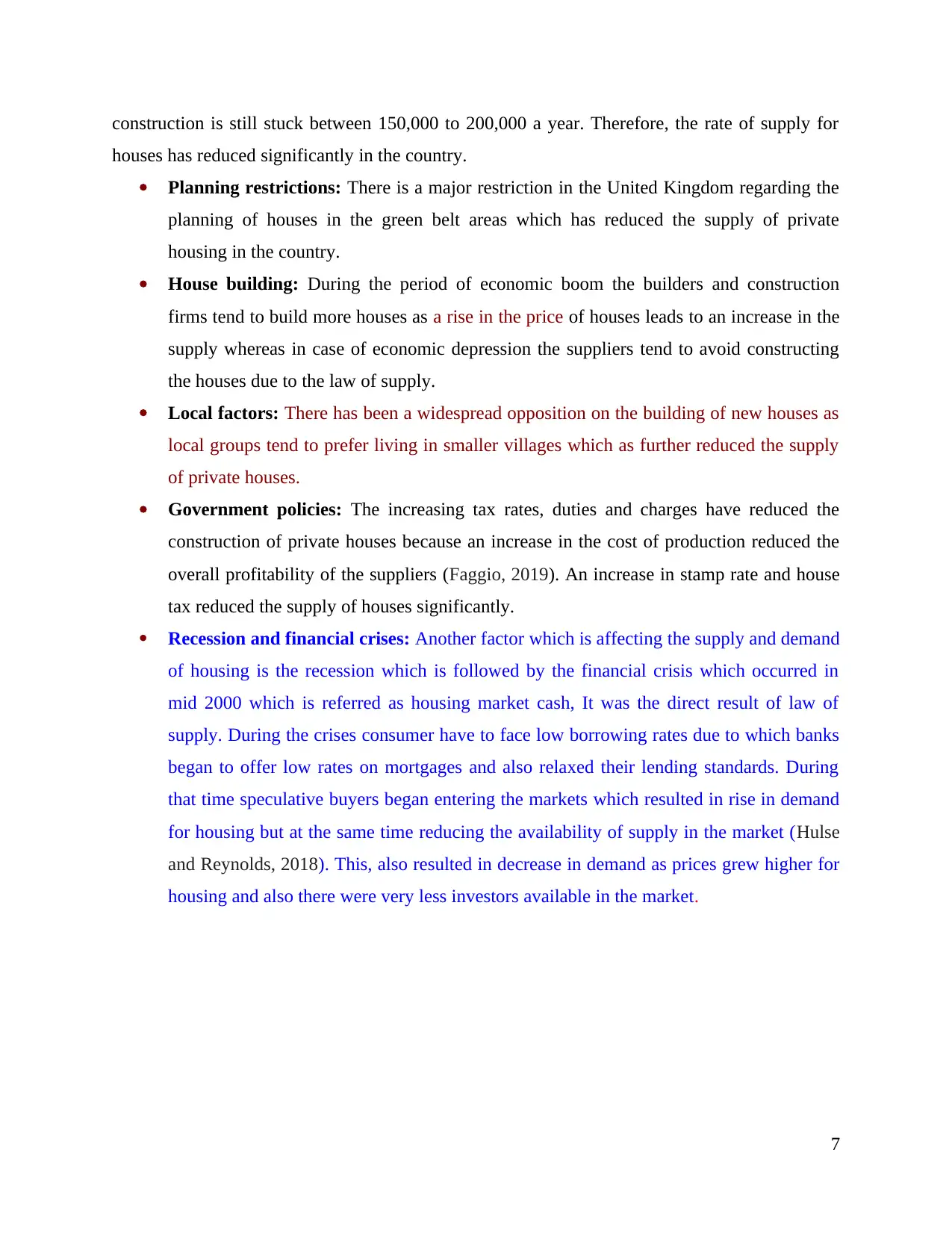
construction is still stuck between 150,000 to 200,000 a year. Therefore, the rate of supply for
houses has reduced significantly in the country.
Planning restrictions: There is a major restriction in the United Kingdom regarding the
planning of houses in the green belt areas which has reduced the supply of private
housing in the country.
House building: During the period of economic boom the builders and construction
firms tend to build more houses as a rise in the price of houses leads to an increase in the
supply whereas in case of economic depression the suppliers tend to avoid constructing
the houses due to the law of supply.
Local factors: There has been a widespread opposition on the building of new houses as
local groups tend to prefer living in smaller villages which as further reduced the supply
of private houses.
Government policies: The increasing tax rates, duties and charges have reduced the
construction of private houses because an increase in the cost of production reduced the
overall profitability of the suppliers (Faggio, 2019). An increase in stamp rate and house
tax reduced the supply of houses significantly.
Recession and financial crises: Another factor which is affecting the supply and demand
of housing is the recession which is followed by the financial crisis which occurred in
mid 2000 which is referred as housing market cash, It was the direct result of law of
supply. During the crises consumer have to face low borrowing rates due to which banks
began to offer low rates on mortgages and also relaxed their lending standards. During
that time speculative buyers began entering the markets which resulted in rise in demand
for housing but at the same time reducing the availability of supply in the market (Hulse
and Reynolds, 2018). This, also resulted in decrease in demand as prices grew higher for
housing and also there were very less investors available in the market.
7
houses has reduced significantly in the country.
Planning restrictions: There is a major restriction in the United Kingdom regarding the
planning of houses in the green belt areas which has reduced the supply of private
housing in the country.
House building: During the period of economic boom the builders and construction
firms tend to build more houses as a rise in the price of houses leads to an increase in the
supply whereas in case of economic depression the suppliers tend to avoid constructing
the houses due to the law of supply.
Local factors: There has been a widespread opposition on the building of new houses as
local groups tend to prefer living in smaller villages which as further reduced the supply
of private houses.
Government policies: The increasing tax rates, duties and charges have reduced the
construction of private houses because an increase in the cost of production reduced the
overall profitability of the suppliers (Faggio, 2019). An increase in stamp rate and house
tax reduced the supply of houses significantly.
Recession and financial crises: Another factor which is affecting the supply and demand
of housing is the recession which is followed by the financial crisis which occurred in
mid 2000 which is referred as housing market cash, It was the direct result of law of
supply. During the crises consumer have to face low borrowing rates due to which banks
began to offer low rates on mortgages and also relaxed their lending standards. During
that time speculative buyers began entering the markets which resulted in rise in demand
for housing but at the same time reducing the availability of supply in the market (Hulse
and Reynolds, 2018). This, also resulted in decrease in demand as prices grew higher for
housing and also there were very less investors available in the market.
7
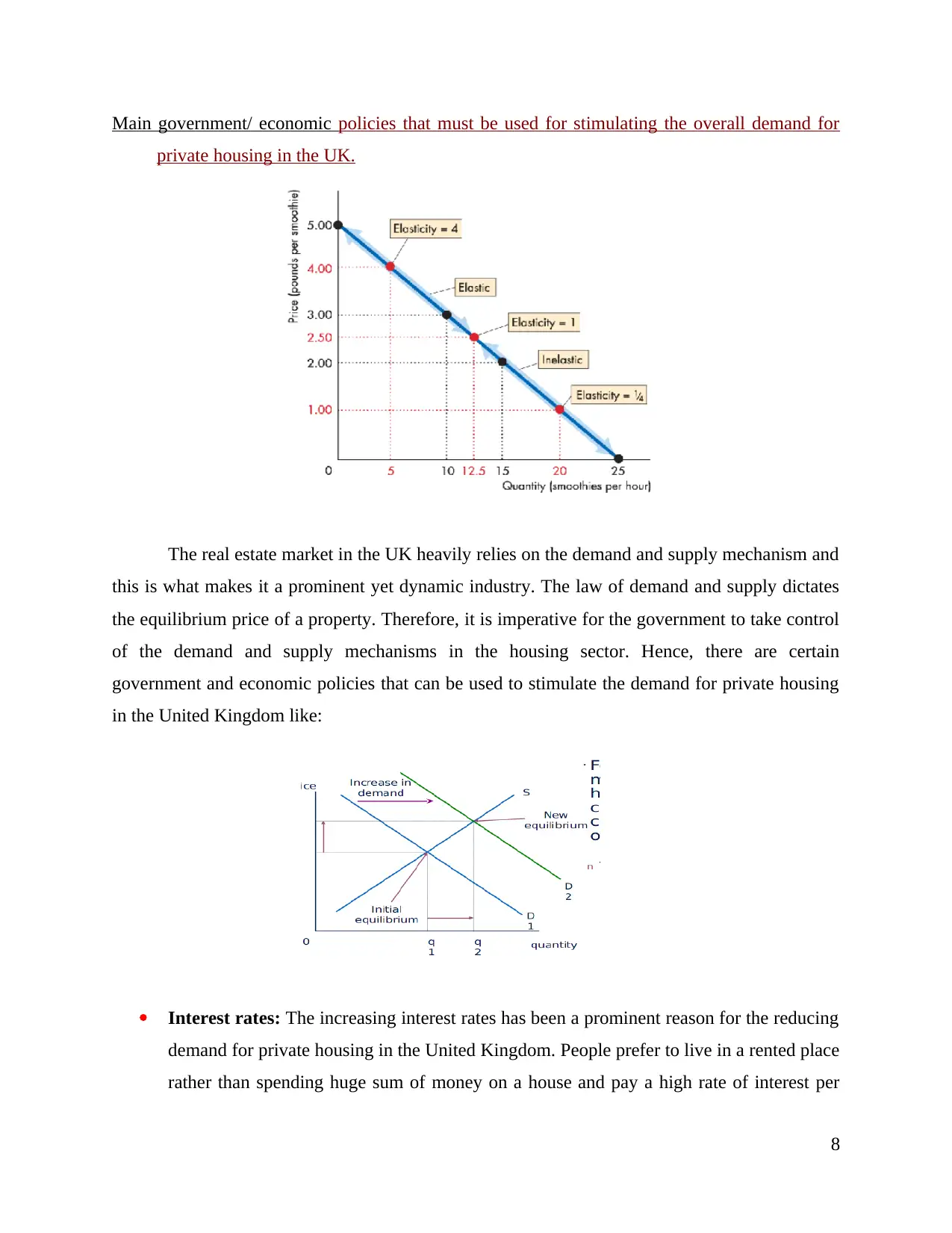
Main government/ economic policies that must be used for stimulating the overall demand for
private housing in the UK.
The real estate market in the UK heavily relies on the demand and supply mechanism and
this is what makes it a prominent yet dynamic industry. The law of demand and supply dictates
the equilibrium price of a property. Therefore, it is imperative for the government to take control
of the demand and supply mechanisms in the housing sector. Hence, there are certain
government and economic policies that can be used to stimulate the demand for private housing
in the United Kingdom like:
Interest rates: The increasing interest rates has been a prominent reason for the reducing
demand for private housing in the United Kingdom. People prefer to live in a rented place
rather than spending huge sum of money on a house and pay a high rate of interest per
8
private housing in the UK.
The real estate market in the UK heavily relies on the demand and supply mechanism and
this is what makes it a prominent yet dynamic industry. The law of demand and supply dictates
the equilibrium price of a property. Therefore, it is imperative for the government to take control
of the demand and supply mechanisms in the housing sector. Hence, there are certain
government and economic policies that can be used to stimulate the demand for private housing
in the United Kingdom like:
Interest rates: The increasing interest rates has been a prominent reason for the reducing
demand for private housing in the United Kingdom. People prefer to live in a rented place
rather than spending huge sum of money on a house and pay a high rate of interest per
8
Secure Best Marks with AI Grader
Need help grading? Try our AI Grader for instant feedback on your assignments.

month/ annum (Lombard, 2019). Therefore, in order to increase the demand for houses it
is important for government to reduce the interest rate on housing loans as it would
further reduce the overall price of housing.
Stamp duty: Stamp duty is the tax paid by the buyer and seller on the purchased
property. The stamp duty rate in the UK is 2% on the purchase of property between
125,000 pounds to 250,000 pounds, 5% if the value lies between 250,001 to 925,000
pounds and 10% if the purchase price is between 925,000 to 1,500,000 pounds. The
government must reduce the stamp duty in order to increase the demand of private
housing. The high rate of stamp duty has hugely affected the London market as people
have dropped the idea of purchasing houses which has also led to many houses remaining
idle in the Central London (Hulse and Reynolds, 2018). The government must also
provide tax reliefs and increase flexibility in order to stimulate the demand of houses and
flats in the country.
Ownership schemes: The UK government has introduced an attractive scheme in order
to increase the demand of housing sector called 'help to buy' scheme. Under this scheme,
the government help people buy their own homes by providing the facility of equity loan
of 20% for the total value of newly built home. It is very beneficial and flexible for the
people as now an individual only requires 5% cash deposit and 75% mortgage to make up
the rest. Also, the government does not charge any loan fees on the 20% equity for the
next five years from the house owner. The scheme was introduced in 2013, in order to
help the people by giving them a leg up (Onstein, Tavasszy and van Damme, 2019). The
scheme helped in building more than 49,000 houses in a single year and helped in
increasing the number of houses by 15%. Therefore, the 'help to buy' scheme played a
significant role in increasing the demand for private households.
Mortgage loans: The banks and financial institutions must become more flexible while
providing loans for building homes. The incessant increase in high mortgage rates has
reduced the demand for home loans in the country. If mortgages become less available
than the demand will fall. The banks are demanding bigger deposits with other terms and
conditions and that has reduced the demand for houses (McKee, Muir and Moore,
2017). Thus, certain economic policies must be implemented to reduce the rate of
mortgage and further increase the demand for housing loans.
9
is important for government to reduce the interest rate on housing loans as it would
further reduce the overall price of housing.
Stamp duty: Stamp duty is the tax paid by the buyer and seller on the purchased
property. The stamp duty rate in the UK is 2% on the purchase of property between
125,000 pounds to 250,000 pounds, 5% if the value lies between 250,001 to 925,000
pounds and 10% if the purchase price is between 925,000 to 1,500,000 pounds. The
government must reduce the stamp duty in order to increase the demand of private
housing. The high rate of stamp duty has hugely affected the London market as people
have dropped the idea of purchasing houses which has also led to many houses remaining
idle in the Central London (Hulse and Reynolds, 2018). The government must also
provide tax reliefs and increase flexibility in order to stimulate the demand of houses and
flats in the country.
Ownership schemes: The UK government has introduced an attractive scheme in order
to increase the demand of housing sector called 'help to buy' scheme. Under this scheme,
the government help people buy their own homes by providing the facility of equity loan
of 20% for the total value of newly built home. It is very beneficial and flexible for the
people as now an individual only requires 5% cash deposit and 75% mortgage to make up
the rest. Also, the government does not charge any loan fees on the 20% equity for the
next five years from the house owner. The scheme was introduced in 2013, in order to
help the people by giving them a leg up (Onstein, Tavasszy and van Damme, 2019). The
scheme helped in building more than 49,000 houses in a single year and helped in
increasing the number of houses by 15%. Therefore, the 'help to buy' scheme played a
significant role in increasing the demand for private households.
Mortgage loans: The banks and financial institutions must become more flexible while
providing loans for building homes. The incessant increase in high mortgage rates has
reduced the demand for home loans in the country. If mortgages become less available
than the demand will fall. The banks are demanding bigger deposits with other terms and
conditions and that has reduced the demand for houses (McKee, Muir and Moore,
2017). Thus, certain economic policies must be implemented to reduce the rate of
mortgage and further increase the demand for housing loans.
9
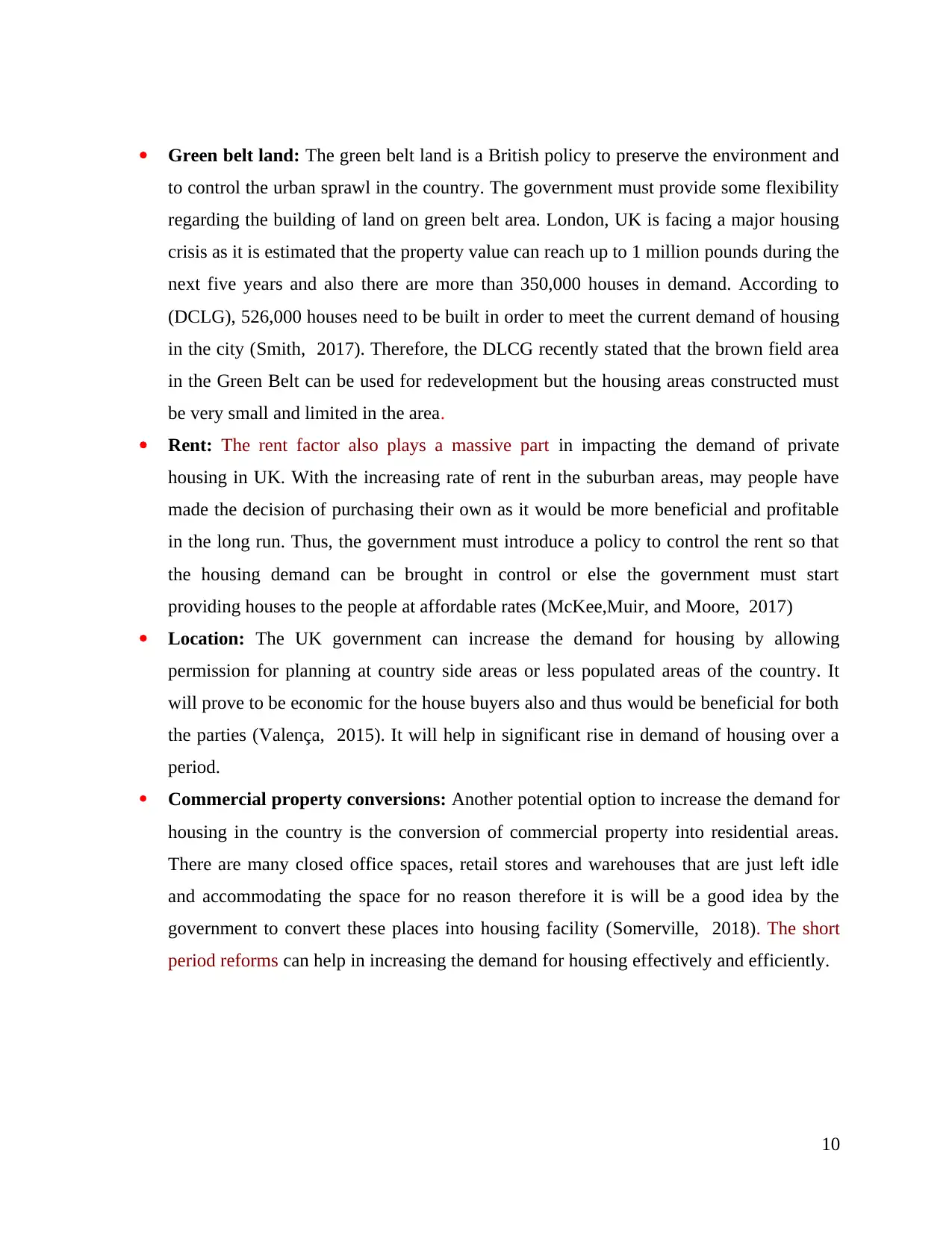
Green belt land: The green belt land is a British policy to preserve the environment and
to control the urban sprawl in the country. The government must provide some flexibility
regarding the building of land on green belt area. London, UK is facing a major housing
crisis as it is estimated that the property value can reach up to 1 million pounds during the
next five years and also there are more than 350,000 houses in demand. According to
(DCLG), 526,000 houses need to be built in order to meet the current demand of housing
in the city (Smith, 2017). Therefore, the DLCG recently stated that the brown field area
in the Green Belt can be used for redevelopment but the housing areas constructed must
be very small and limited in the area.
Rent: The rent factor also plays a massive part in impacting the demand of private
housing in UK. With the increasing rate of rent in the suburban areas, may people have
made the decision of purchasing their own as it would be more beneficial and profitable
in the long run. Thus, the government must introduce a policy to control the rent so that
the housing demand can be brought in control or else the government must start
providing houses to the people at affordable rates (McKee,Muir, and Moore, 2017)
Location: The UK government can increase the demand for housing by allowing
permission for planning at country side areas or less populated areas of the country. It
will prove to be economic for the house buyers also and thus would be beneficial for both
the parties (Valença, 2015). It will help in significant rise in demand of housing over a
period.
Commercial property conversions: Another potential option to increase the demand for
housing in the country is the conversion of commercial property into residential areas.
There are many closed office spaces, retail stores and warehouses that are just left idle
and accommodating the space for no reason therefore it is will be a good idea by the
government to convert these places into housing facility (Somerville, 2018). The short
period reforms can help in increasing the demand for housing effectively and efficiently.
10
to control the urban sprawl in the country. The government must provide some flexibility
regarding the building of land on green belt area. London, UK is facing a major housing
crisis as it is estimated that the property value can reach up to 1 million pounds during the
next five years and also there are more than 350,000 houses in demand. According to
(DCLG), 526,000 houses need to be built in order to meet the current demand of housing
in the city (Smith, 2017). Therefore, the DLCG recently stated that the brown field area
in the Green Belt can be used for redevelopment but the housing areas constructed must
be very small and limited in the area.
Rent: The rent factor also plays a massive part in impacting the demand of private
housing in UK. With the increasing rate of rent in the suburban areas, may people have
made the decision of purchasing their own as it would be more beneficial and profitable
in the long run. Thus, the government must introduce a policy to control the rent so that
the housing demand can be brought in control or else the government must start
providing houses to the people at affordable rates (McKee,Muir, and Moore, 2017)
Location: The UK government can increase the demand for housing by allowing
permission for planning at country side areas or less populated areas of the country. It
will prove to be economic for the house buyers also and thus would be beneficial for both
the parties (Valença, 2015). It will help in significant rise in demand of housing over a
period.
Commercial property conversions: Another potential option to increase the demand for
housing in the country is the conversion of commercial property into residential areas.
There are many closed office spaces, retail stores and warehouses that are just left idle
and accommodating the space for no reason therefore it is will be a good idea by the
government to convert these places into housing facility (Somerville, 2018). The short
period reforms can help in increasing the demand for housing effectively and efficiently.
10
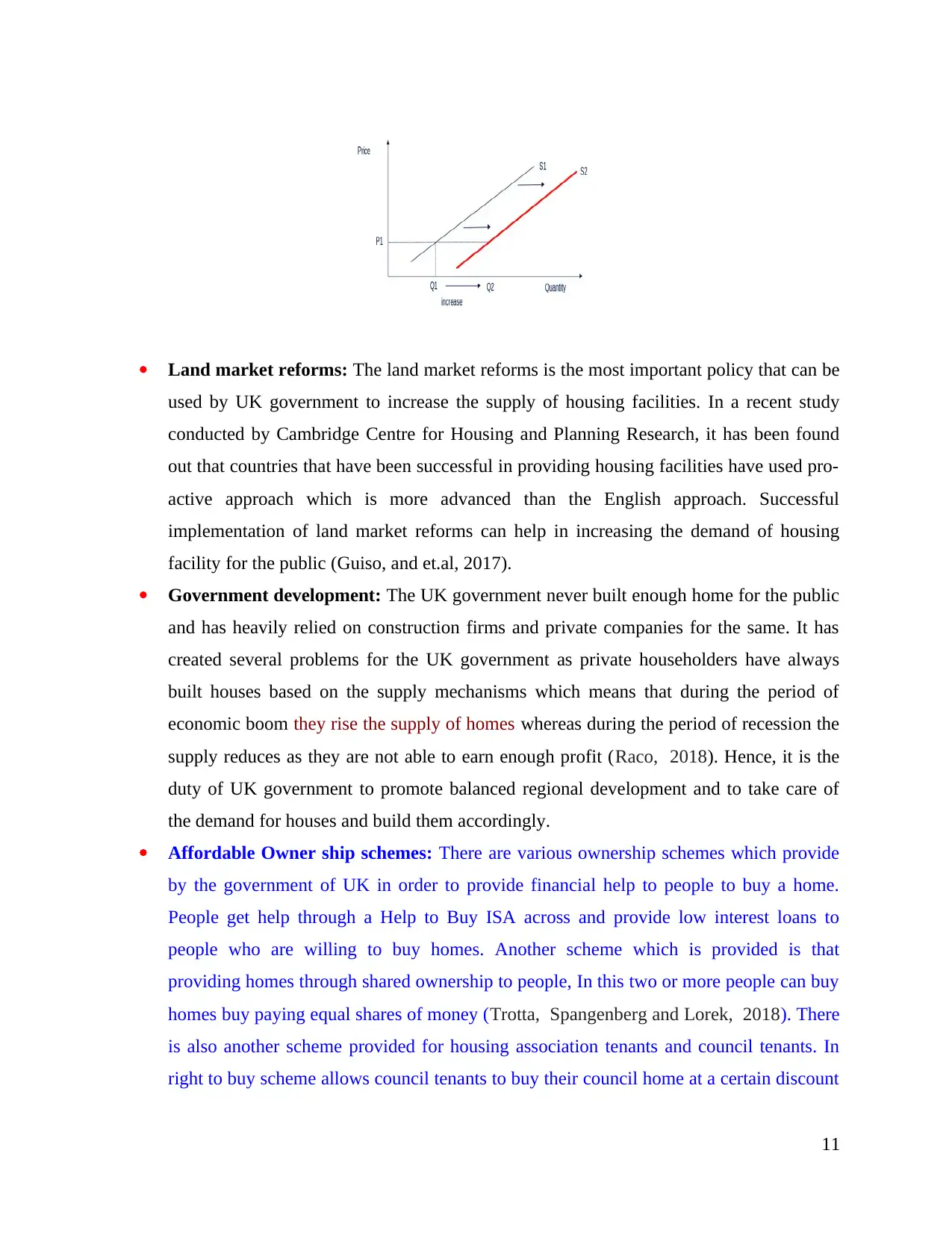
Land market reforms: The land market reforms is the most important policy that can be
used by UK government to increase the supply of housing facilities. In a recent study
conducted by Cambridge Centre for Housing and Planning Research, it has been found
out that countries that have been successful in providing housing facilities have used pro-
active approach which is more advanced than the English approach. Successful
implementation of land market reforms can help in increasing the demand of housing
facility for the public (Guiso, and et.al, 2017).
Government development: The UK government never built enough home for the public
and has heavily relied on construction firms and private companies for the same. It has
created several problems for the UK government as private householders have always
built houses based on the supply mechanisms which means that during the period of
economic boom they rise the supply of homes whereas during the period of recession the
supply reduces as they are not able to earn enough profit (Raco, 2018). Hence, it is the
duty of UK government to promote balanced regional development and to take care of
the demand for houses and build them accordingly.
Affordable Owner ship schemes: There are various ownership schemes which provide
by the government of UK in order to provide financial help to people to buy a home.
People get help through a Help to Buy ISA across and provide low interest loans to
people who are willing to buy homes. Another scheme which is provided is that
providing homes through shared ownership to people, In this two or more people can buy
homes buy paying equal shares of money (Trotta, Spangenberg and Lorek, 2018). There
is also another scheme provided for housing association tenants and council tenants. In
right to buy scheme allows council tenants to buy their council home at a certain discount
11
used by UK government to increase the supply of housing facilities. In a recent study
conducted by Cambridge Centre for Housing and Planning Research, it has been found
out that countries that have been successful in providing housing facilities have used pro-
active approach which is more advanced than the English approach. Successful
implementation of land market reforms can help in increasing the demand of housing
facility for the public (Guiso, and et.al, 2017).
Government development: The UK government never built enough home for the public
and has heavily relied on construction firms and private companies for the same. It has
created several problems for the UK government as private householders have always
built houses based on the supply mechanisms which means that during the period of
economic boom they rise the supply of homes whereas during the period of recession the
supply reduces as they are not able to earn enough profit (Raco, 2018). Hence, it is the
duty of UK government to promote balanced regional development and to take care of
the demand for houses and build them accordingly.
Affordable Owner ship schemes: There are various ownership schemes which provide
by the government of UK in order to provide financial help to people to buy a home.
People get help through a Help to Buy ISA across and provide low interest loans to
people who are willing to buy homes. Another scheme which is provided is that
providing homes through shared ownership to people, In this two or more people can buy
homes buy paying equal shares of money (Trotta, Spangenberg and Lorek, 2018). There
is also another scheme provided for housing association tenants and council tenants. In
right to buy scheme allows council tenants to buy their council home at a certain discount
11
Paraphrase This Document
Need a fresh take? Get an instant paraphrase of this document with our AI Paraphraser
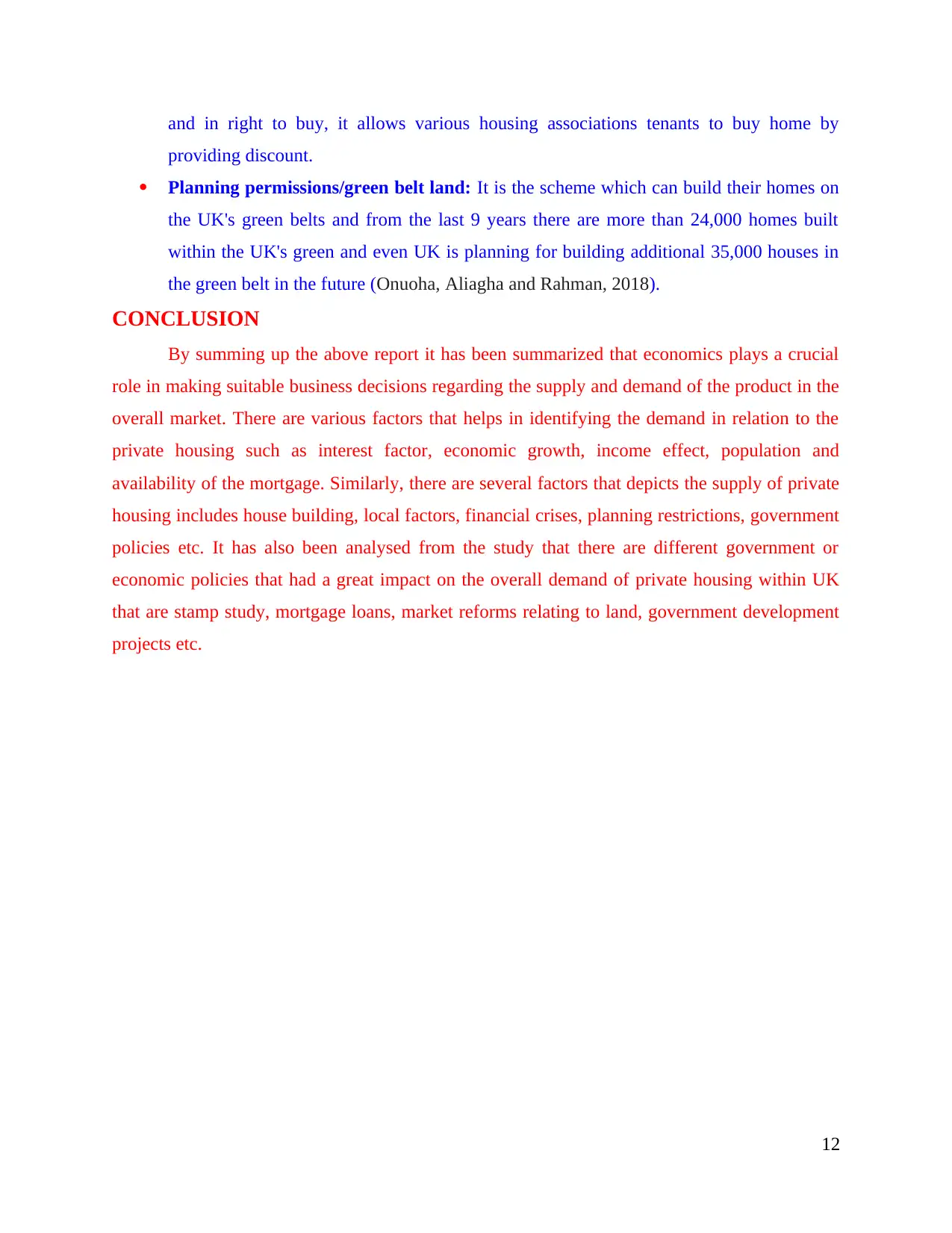
and in right to buy, it allows various housing associations tenants to buy home by
providing discount.
Planning permissions/green belt land: It is the scheme which can build their homes on
the UK's green belts and from the last 9 years there are more than 24,000 homes built
within the UK's green and even UK is planning for building additional 35,000 houses in
the green belt in the future (Onuoha, Aliagha and Rahman, 2018).
CONCLUSION
By summing up the above report it has been summarized that economics plays a crucial
role in making suitable business decisions regarding the supply and demand of the product in the
overall market. There are various factors that helps in identifying the demand in relation to the
private housing such as interest factor, economic growth, income effect, population and
availability of the mortgage. Similarly, there are several factors that depicts the supply of private
housing includes house building, local factors, financial crises, planning restrictions, government
policies etc. It has also been analysed from the study that there are different government or
economic policies that had a great impact on the overall demand of private housing within UK
that are stamp study, mortgage loans, market reforms relating to land, government development
projects etc.
12
providing discount.
Planning permissions/green belt land: It is the scheme which can build their homes on
the UK's green belts and from the last 9 years there are more than 24,000 homes built
within the UK's green and even UK is planning for building additional 35,000 houses in
the green belt in the future (Onuoha, Aliagha and Rahman, 2018).
CONCLUSION
By summing up the above report it has been summarized that economics plays a crucial
role in making suitable business decisions regarding the supply and demand of the product in the
overall market. There are various factors that helps in identifying the demand in relation to the
private housing such as interest factor, economic growth, income effect, population and
availability of the mortgage. Similarly, there are several factors that depicts the supply of private
housing includes house building, local factors, financial crises, planning restrictions, government
policies etc. It has also been analysed from the study that there are different government or
economic policies that had a great impact on the overall demand of private housing within UK
that are stamp study, mortgage loans, market reforms relating to land, government development
projects etc.
12
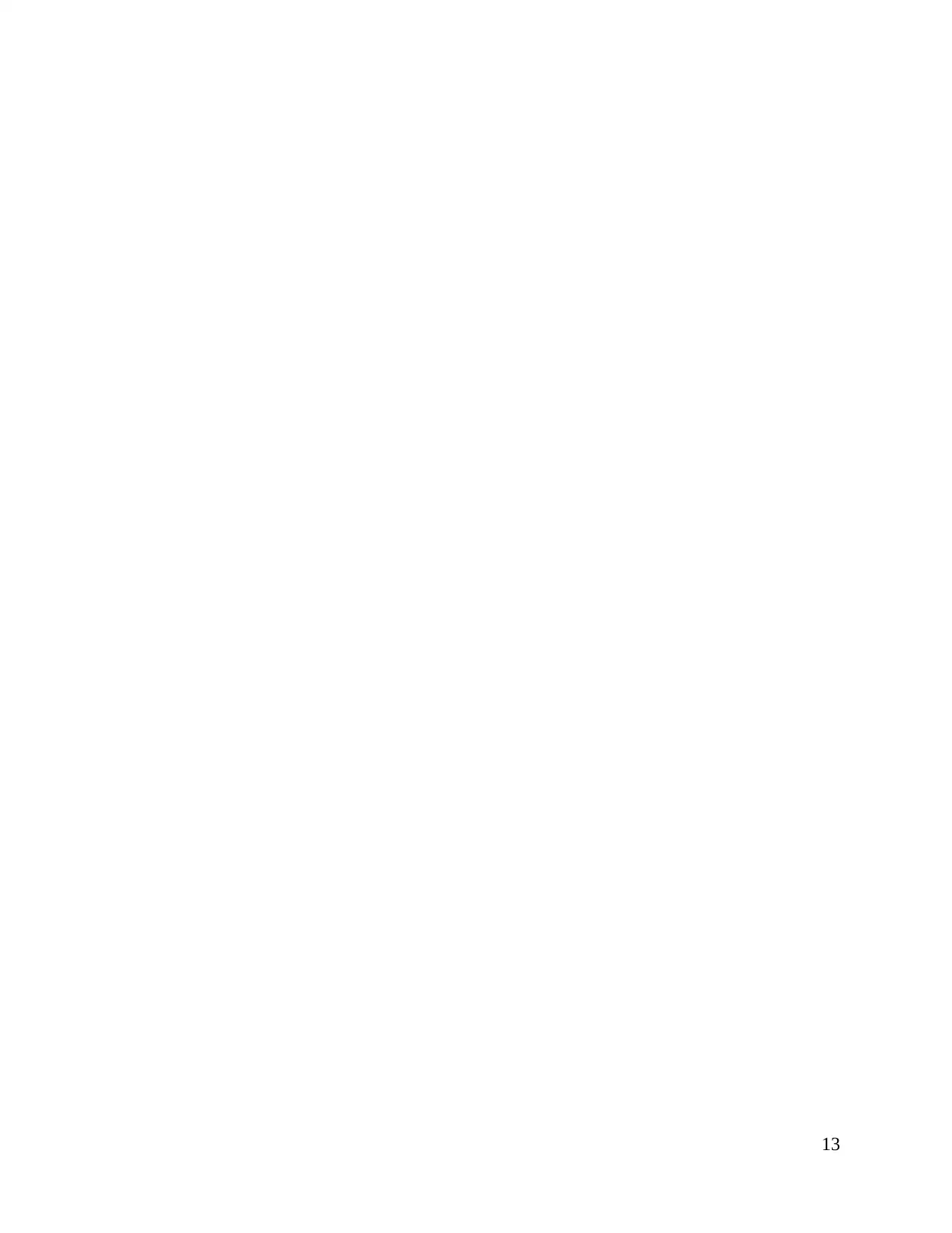
13
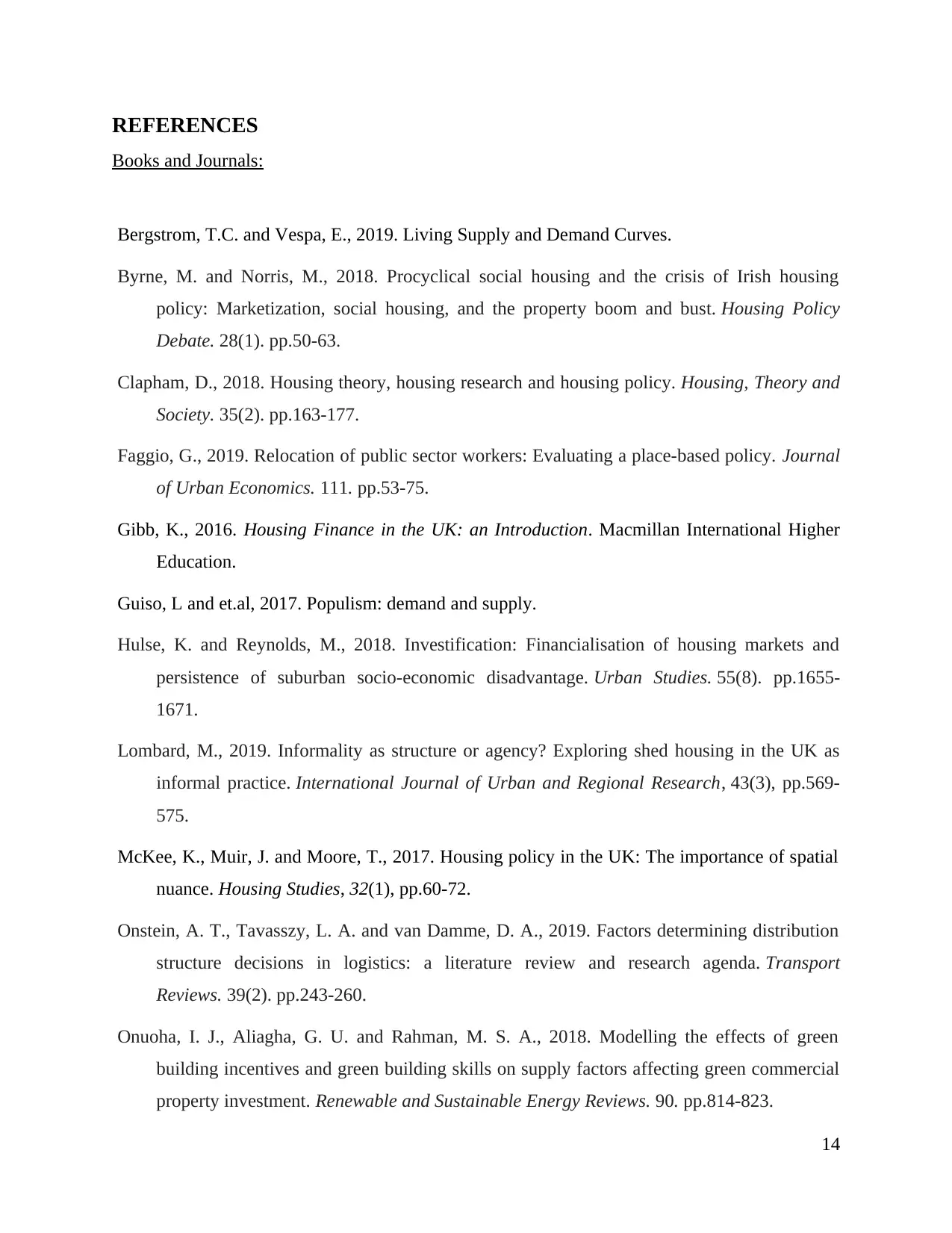
REFERENCES
Books and Journals:
Bergstrom, T.C. and Vespa, E., 2019. Living Supply and Demand Curves.
Byrne, M. and Norris, M., 2018. Procyclical social housing and the crisis of Irish housing
policy: Marketization, social housing, and the property boom and bust. Housing Policy
Debate. 28(1). pp.50-63.
Clapham, D., 2018. Housing theory, housing research and housing policy. Housing, Theory and
Society. 35(2). pp.163-177.
Faggio, G., 2019. Relocation of public sector workers: Evaluating a place-based policy. Journal
of Urban Economics. 111. pp.53-75.
Gibb, K., 2016. Housing Finance in the UK: an Introduction. Macmillan International Higher
Education.
Guiso, L and et.al, 2017. Populism: demand and supply.
Hulse, K. and Reynolds, M., 2018. Investification: Financialisation of housing markets and
persistence of suburban socio-economic disadvantage. Urban Studies. 55(8). pp.1655-
1671.
Lombard, M., 2019. Informality as structure or agency? Exploring shed housing in the UK as
informal practice. International Journal of Urban and Regional Research, 43(3), pp.569-
575.
McKee, K., Muir, J. and Moore, T., 2017. Housing policy in the UK: The importance of spatial
nuance. Housing Studies, 32(1), pp.60-72.
Onstein, A. T., Tavasszy, L. A. and van Damme, D. A., 2019. Factors determining distribution
structure decisions in logistics: a literature review and research agenda. Transport
Reviews. 39(2). pp.243-260.
Onuoha, I. J., Aliagha, G. U. and Rahman, M. S. A., 2018. Modelling the effects of green
building incentives and green building skills on supply factors affecting green commercial
property investment. Renewable and Sustainable Energy Reviews. 90. pp.814-823.
14
Books and Journals:
Bergstrom, T.C. and Vespa, E., 2019. Living Supply and Demand Curves.
Byrne, M. and Norris, M., 2018. Procyclical social housing and the crisis of Irish housing
policy: Marketization, social housing, and the property boom and bust. Housing Policy
Debate. 28(1). pp.50-63.
Clapham, D., 2018. Housing theory, housing research and housing policy. Housing, Theory and
Society. 35(2). pp.163-177.
Faggio, G., 2019. Relocation of public sector workers: Evaluating a place-based policy. Journal
of Urban Economics. 111. pp.53-75.
Gibb, K., 2016. Housing Finance in the UK: an Introduction. Macmillan International Higher
Education.
Guiso, L and et.al, 2017. Populism: demand and supply.
Hulse, K. and Reynolds, M., 2018. Investification: Financialisation of housing markets and
persistence of suburban socio-economic disadvantage. Urban Studies. 55(8). pp.1655-
1671.
Lombard, M., 2019. Informality as structure or agency? Exploring shed housing in the UK as
informal practice. International Journal of Urban and Regional Research, 43(3), pp.569-
575.
McKee, K., Muir, J. and Moore, T., 2017. Housing policy in the UK: The importance of spatial
nuance. Housing Studies, 32(1), pp.60-72.
Onstein, A. T., Tavasszy, L. A. and van Damme, D. A., 2019. Factors determining distribution
structure decisions in logistics: a literature review and research agenda. Transport
Reviews. 39(2). pp.243-260.
Onuoha, I. J., Aliagha, G. U. and Rahman, M. S. A., 2018. Modelling the effects of green
building incentives and green building skills on supply factors affecting green commercial
property investment. Renewable and Sustainable Energy Reviews. 90. pp.814-823.
14
Secure Best Marks with AI Grader
Need help grading? Try our AI Grader for instant feedback on your assignments.

Raco, M., 2018. Private consultants, planning reform and the marketisation of local government
finance. In Planning Practice (pp. 147-161). Routledge.
Smith, P., 2017. Affordable housing and private rented sector reform. In Smart Urban
Regeneration (pp. 270-289). Routledge.
Somerville, P., 2018. 27. Housing and social justice. Handbook on Global Social Justice, p.371.
Trotta, G., Spangenberg, J. and Lorek, S., 2018. Energy efficiency in the residential sector:
identification of promising policy instruments and private initiatives among selected
European countries. Energy Efficiency. 11(8). pp.2111-2135.
Valença, M.M., 2015. Social rental housing in HK and the UK: Neoliberal policy divergence or
the market in the making?. Habitat International, 49, pp.107-114.
Watt, P. and Minton, A., 2016. London's housing crisis and its activisms: Introduction. City,
20(2), pp.204-221.
15
finance. In Planning Practice (pp. 147-161). Routledge.
Smith, P., 2017. Affordable housing and private rented sector reform. In Smart Urban
Regeneration (pp. 270-289). Routledge.
Somerville, P., 2018. 27. Housing and social justice. Handbook on Global Social Justice, p.371.
Trotta, G., Spangenberg, J. and Lorek, S., 2018. Energy efficiency in the residential sector:
identification of promising policy instruments and private initiatives among selected
European countries. Energy Efficiency. 11(8). pp.2111-2135.
Valença, M.M., 2015. Social rental housing in HK and the UK: Neoliberal policy divergence or
the market in the making?. Habitat International, 49, pp.107-114.
Watt, P. and Minton, A., 2016. London's housing crisis and its activisms: Introduction. City,
20(2), pp.204-221.
15
1 out of 17
Related Documents
Your All-in-One AI-Powered Toolkit for Academic Success.
+13062052269
info@desklib.com
Available 24*7 on WhatsApp / Email
![[object Object]](/_next/static/media/star-bottom.7253800d.svg)
Unlock your academic potential
© 2024 | Zucol Services PVT LTD | All rights reserved.





